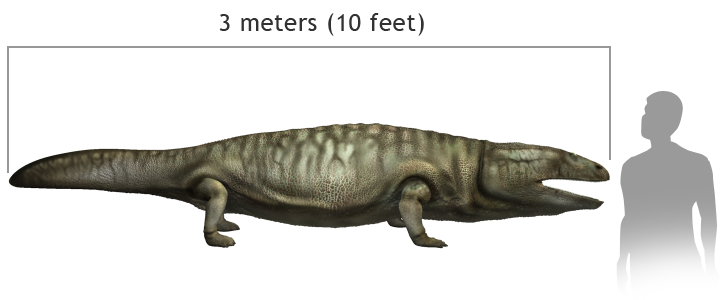Post by Infinity Blade on Mar 28, 2015 23:16:34 GMT 5
Metoposaurus spp.

Life reconstruction with human for scale, © Dinosaur Zoo / Wikimedia CC BY-SA 3.0
Temporal range: Late Triassic (Carnian: ~228-216.5Ma)
Scientific classification:
Domain: Eukaryota
(unranked): Unikonta
(unranked): Opisthokonta
(unranked): Holozoa
(unranked): Filozoa
Kingdom: Animalia
Subkingdom: Eumetazoa
(unranked): Bilateria
Superphylum: Deuterostomia
Phylum: Chordata
Infraphylum: Gnathostomata
Clade: Eugnathostomata
Clade: Teleostomi
Superclass: Tetrapoda
Order: †Temnospondyli
Clade: †Limnarchia
Clade: †Stereospondylomorpha
Suborder: †Stereospondyli
Clade: †Trematosauria
Superfamily: †Metoposauroidea
Family: †Metoposauridae
Genus: †Metoposaurus
Species: †M. diagnosticus
†M. maleriensis
†M. algarvensis
Metoposaurus ("front lizard") is a genus of temnospondyl that lived during the Carnian stage of the Late Triassic. It was an amphibious creature that possessed weak limbs and a huge, flat head and jaws with numerous pointed teeth. Metoposaurus' aquatic locomotion involved its limbs acting as flippers and moved overall like plesiosaurs with symmetrical and synchronous movements of the limbs (the tail was flexible and was likely used as a rudder).[1] Physical characteristics of Metoposaurus including its broad dorsoventrally flattened head, broad and flat limb elements, wide manus, and large tail were used to suggest the notion that the animal swam in epheremal lakes in the wet season; when the dry season began, Metoposaurus would supposedly use its head and forelimbs to burrow underground. The medullary region was found to have substantial trabecular bone and the annuli were interpreted as corresponding to "the two-seasonal climate with a short, more favorable wet season and a long dry part of the year when life conditions were worse".[2][3] Dr. Michel Laurin had issues with this conclusion for reasons twofold; firstly, Metoposaurus was significantly larger than any extant burrowing species and secondly, it was suspected the rostrum and tail played a much greater role than the limbs.[3] Metoposaurus algarvensis was recently discovered and was stated to have had a crocodile-like niche (this was extended to all metoposaurids actually).[4]
References:
[1] "Osteology, variability, and variability of Metoposaurus, a temnospondyl from the Late Triassic of Poland." (Sulej, 2007).
[2] "Unique growth pattern of Metoposaurus diagnosticus krasiejowensis (Amphibia, Temnospondyli) from the Upper Triassic of Krasiejów, Poland." (Konietzko-Meier & Klein, 2013).
[3] phys.org/news/2013-09-giant-triassic-amphibian-burrowing-youngster.html
[4] "A new species of Metoposaurus from the Late Triassic of Portugal and comments on the systematics and biogeography of metoposaurid temnospondyls" (Brusatte et al., 2015).

Life reconstruction with human for scale, © Dinosaur Zoo / Wikimedia CC BY-SA 3.0
Temporal range: Late Triassic (Carnian: ~228-216.5Ma)
Scientific classification:
Domain: Eukaryota
(unranked): Unikonta
(unranked): Opisthokonta
(unranked): Holozoa
(unranked): Filozoa
Kingdom: Animalia
Subkingdom: Eumetazoa
(unranked): Bilateria
Superphylum: Deuterostomia
Phylum: Chordata
Infraphylum: Gnathostomata
Clade: Eugnathostomata
Clade: Teleostomi
Superclass: Tetrapoda
Order: †Temnospondyli
Clade: †Limnarchia
Clade: †Stereospondylomorpha
Suborder: †Stereospondyli
Clade: †Trematosauria
Superfamily: †Metoposauroidea
Family: †Metoposauridae
Genus: †Metoposaurus
Species: †M. diagnosticus
†M. maleriensis
†M. algarvensis
Metoposaurus ("front lizard") is a genus of temnospondyl that lived during the Carnian stage of the Late Triassic. It was an amphibious creature that possessed weak limbs and a huge, flat head and jaws with numerous pointed teeth. Metoposaurus' aquatic locomotion involved its limbs acting as flippers and moved overall like plesiosaurs with symmetrical and synchronous movements of the limbs (the tail was flexible and was likely used as a rudder).[1] Physical characteristics of Metoposaurus including its broad dorsoventrally flattened head, broad and flat limb elements, wide manus, and large tail were used to suggest the notion that the animal swam in epheremal lakes in the wet season; when the dry season began, Metoposaurus would supposedly use its head and forelimbs to burrow underground. The medullary region was found to have substantial trabecular bone and the annuli were interpreted as corresponding to "the two-seasonal climate with a short, more favorable wet season and a long dry part of the year when life conditions were worse".[2][3] Dr. Michel Laurin had issues with this conclusion for reasons twofold; firstly, Metoposaurus was significantly larger than any extant burrowing species and secondly, it was suspected the rostrum and tail played a much greater role than the limbs.[3] Metoposaurus algarvensis was recently discovered and was stated to have had a crocodile-like niche (this was extended to all metoposaurids actually).[4]
References:
[1] "Osteology, variability, and variability of Metoposaurus, a temnospondyl from the Late Triassic of Poland." (Sulej, 2007).
[2] "Unique growth pattern of Metoposaurus diagnosticus krasiejowensis (Amphibia, Temnospondyli) from the Upper Triassic of Krasiejów, Poland." (Konietzko-Meier & Klein, 2013).
[3] phys.org/news/2013-09-giant-triassic-amphibian-burrowing-youngster.html
[4] "A new species of Metoposaurus from the Late Triassic of Portugal and comments on the systematics and biogeography of metoposaurid temnospondyls" (Brusatte et al., 2015).



